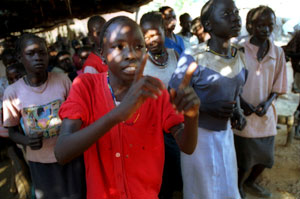


|
|
| Robert
O. Collins, Professor Emeritus, Department of History University of California, Santa Barbara |
|
|
| Dr. Francis Mading Deng, Distinguished Professor of Political Science and Co-Director of the CUNY Graduate Center-Brookings Project on Internal Displacement; Special Representative of the UN Secretary-General on Internally Displaced Persons |
|
|
| Helen Fein, Executive Director, Institute for the Study of Genocide at John Jay College of Criminal Justice, City University of New York |
|
|
| Jerry
Fowler, Staff Director Committee on Conscience U.S. Holocaust Memorial Museum |
|
|
| Sondra
Hale, Adjunct Professor of Anthropology and Women’s Studies, UCLA |
|
|
| Randolph
Martin, Senior Director for Operations, International Rescue Committee |
|
|
| Join the discussion |
|
|
|
April
2002
|
|
For example, if a warrior is wounded, he may no longer be killed. Women are there to assist, right on the battlefield. When a soldier falls, and a woman comes to cover his body with her own and to help him out of the battlefield, he must no longer be killed. The woman is a sheltering nurse, and the soldier is no longer to be touched by the enemy.
War is preceded by prayers, ritual blessings, hymns of atonement, and morale-boosting songs; it takes place on a battlefield or open area where warriors dart each other with spears. Outside this battlefield, no one is to be touched. You do not kill someone who is not in battle. There must be no ambush. You do not surprise the enemy by attacking; you must give an alert, and both sides then prepare. Then meet on the battlefield in the daytime. All of these rules are part of cultures that recognize the dignity of the individual, that refrain from demonizing each other into strangers and animals to be killed with absolute immunity. Now in crises of national identity, there is a great tendency to objectify, to demonize the other, and a consequent loosening of moral constraints. This makes for a genocidal context, where the other is considered deserving only of assimilation, subjugation or elimination. The issue of children in armed conflict is one that needs to be studied at the deepest cultural levels. If you have children training from the very beginning to become soldiers, then they are eager to demonstrate the attributes that confer identity and dignity. One of the things you encounter among the Dinka is that even youngsters who are underage are eager to become initiated as warriors. Indeed, they go through mock initiation in which they act the ordeal of initiation, compose initiation songs of valor, and perform initiation dances. The son’s struggle with the father who insists he is too young to fight and must wait until he reaches the prescribed age is a common theme in initiation songs. Once initiated, a boy is not only a warrior, but also a gentleman, a source of pride for his family and community and especially the aspiring girl friends, with whom relations before initiation are frowned upon and discouraged. The excitement associated with initiation is very profound. In their eagerness to prove themselves in war, they are easily provoked by the slightest insult to their dignity as a group or as members of a corporate identity. And once battle erupts, it breeds more violent confrontations. Clan and communal solidarity dictate that the violent death of a relative needs to be avenged. So there is a predisposition to continue the feuding into future generations. This, then, is the framework of young men in a warrior culture who have been displaced outside the traditional context, some of whom have ironically experienced war outside the supportive environment of their indigenous culture. Their soldierly enthusiasm is easily exploited by rebel forces and government militias. There is no training in the proper ethics of war, and because the recruits—or abductees—are so young, they may not yet have been schooled in traditional rules. But the youngsters may not be forced in the way the West sees it; these are people coming from a culture that predisposes them to be exploitable. The introduction of machine guns, tanks, bombs and heavy artillery lays waste the traditional laws of battle. But the problem doesn’t stop with weaponry: the targeting of civilians and worse, women and children—unthinkable in traditional Dinka warfare--has become a universal phenomenon in the genocidal war of identities. All the paradigms these communities have developed and lived with get overturned—yet another level of cultural loss. For the Dinka, a fighter who targets civilians divests himself of the dignity of a warrior, a reaction that may cause its own share of terrible reprisals. F.M.D Photos Copyright © Meredith Davenport Main
Article
|
This site © Crimes of War Project 1999-2003 |
|
